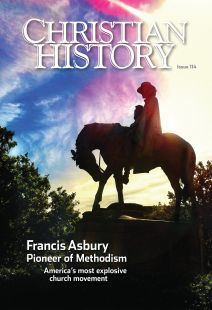Camp meetings: a Methodist invention?
WHEN TELLING THE STORY of how the Second Great Awakening caught fire at the beginning of the nineteenth century, people often emphasize Presbyterian-affiliated camp meetings held in Kentucky, especially at Cane Ridge in 1801 (see CH 106, A Church to End All Churches?). Supposedly these meetings were novel in their size, length, methods, and types of exuberant behavior, spurred on by harsh frontier conditions, as people experienced the grace of God.
While revival took off in a big way in 1801, there is much more to the story. Camp meetings shared features with Presbyterian “sacramental seasons” reaching back over a century and across an ocean. And first-hand Methodist accounts make it clear that revival elements people saw and experienced in 1801 had also been part and parcel of Methodist life for several decades.
Outward exuberant behavior associated with worship and conversion? Common since the 1770s, and as much due to the nature of Methodism itself as to the frontier. Altar calls and mourners’ benches? Methodists had started to use these techniques in the 1790s, finding it easier to call people forward for prayer than to try to reach them in packed worship spaces. Multiday meetings combining worship, sacraments, evangelism, and revival? Methodists had been there and done that ever since a revival had broken out at a Virginia Quarterly Meeting in 1776.
Asbury gushed in 1802: “I have a variety of letters, conveying the pleasing intelligence of the work of God in every State, district, and in most of the circuits in the Union.” He had begun to receive such letters in 1799. Other churches may have been claiming the credit, but Methodists were just as likely to be getting the results.
By Lester Ruth
[Christian History originally published this article in Christian History Issue #114 in 2015]
Lester Ruth is a research professor of Christian worship at Duke Divinity School and the author of A Little Heaven Below: Worship at Early Methodist Quarterly Meetings and Early Methodist Life and Spirituality.Next articles
The bishop and his mentor
The saintly German leader who influenced and frustrated Asbury
J. Steven O’Malley“My chains fell off”: Richard Allen and Francis Asbury
Jennifer Woodruff TaitChristian History Timeline: Methodists on the move
How Methodism transformed in America from a small immigrant sect to a leading Protestant denomination
the editorsA new kind of Methodism and a new kind of bishop
Matthew Simpson’s journey began very much like Asbury’s, but it did not end that way
Scott KiskerSupport us
Christian History Institute (CHI) is a non-profit Pennsylvania corporation founded in 1982. Your donations support the continuation of this ministry
Donate



